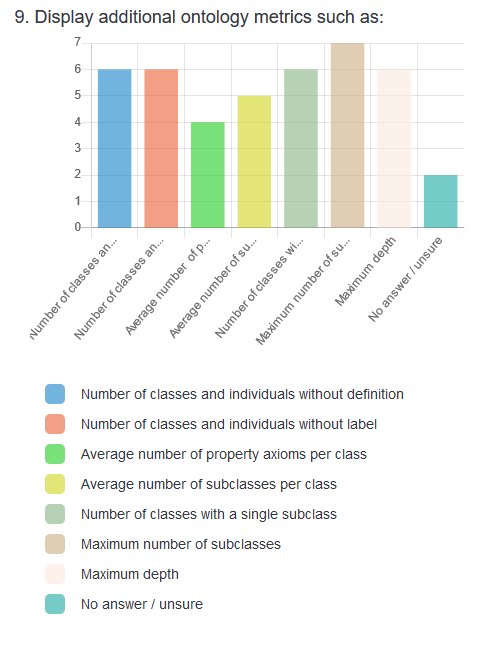Summary of Survey Results: “Improving the ESS Collection” in the TIB Terminology Service
The survey aimed to collect feedback on ways to enhance the ESS terminology documentation and its related features. The ESS collection (https://terminology.nfdi4earth.de) is part of the Terminology Service operated by TIB (TIB TS). Responses covered several aspects of documentation quality, version information, and ontology metrics. Our Survey “Improving the ESS Collection” was answered by 42 participants.
Below is an overview of the findings:
- Improving documentation:
- Participants selected multiple ways to enhance the terminology’s documentation.
The most frequent answer was the preference for a link to an additional description of the terminology, but others would also like to see the information on the number of terms or concepts with labels and comments or the number of concepts defined by axioms.
- Participants selected multiple ways to enhance the terminology’s documentation.
- Additional information about the versions of a terminology:
- Most respondents prefer a list of changes between two versions of a terminology. Respondents highlighted the need for clearer presentation of version details of the terminology. Information about changes can already be found at the landing page of a terminology under “Change Management” (only for terminologies hosted on Github).
- Fewer participants also would accept if this information was provided by a link to information about the changes.
- Imported parts of other terminologies:
- Most participants would like to see whether terminologies are only a part or reuse parts of another ontology. In the TIB TS it is possible to find a list of all terminologies from which terms were imported.
- Most participants would like to see whether terminologies are only a part or reuse parts of another ontology. In the TIB TS it is possible to find a list of all terminologies from which terms were imported.
- Information about the identifiers of a terminology’s term:
- Most respondents highlight the need for more information about the identifiers, either in the form of the number of persistent identifiers (e.g. purls or w3id), the number of resolvable identifiers and the number of terms which resolve to machine-actionable information. NFDI4ING is developing a PID Checker that e.g. counts for each terminology the number of PIDs that are not resolving. It will be introduced to TIB TS as soon as the development and testing has been finished.
- Most respondents highlight the need for more information about the identifiers, either in the form of the number of persistent identifiers (e.g. purls or w3id), the number of resolvable identifiers and the number of terms which resolve to machine-actionable information. NFDI4ING is developing a PID Checker that e.g. counts for each terminology the number of PIDs that are not resolving. It will be introduced to TIB TS as soon as the development and testing has been finished.
- Community acceptance:
- Participants showed interest in the information, which projects, institutions, or groups use a respective terminology for their work and which groups have developed a terminology.
- Participants showed interest in the information, which projects, institutions, or groups use a respective terminology for their work and which groups have developed a terminology.
- Terminology is required for reportings or submission of data:
- Most participants would like to get the information whether a terminology is required in special reportings or the submission of data.
- Most participants would like to get the information whether a terminology is required in special reportings or the submission of data.
- Mappings or information about mappings:
- Most respondents would like to have information about mappings.
- The majority would prefer if the mappings would be provided together with the information of their quality and provenance.
- Quality assurance and control:
- Participants showed interest in displaying the results of quality assurance and quality control performed by third parties, with links to the results.
- Participants showed interest in displaying the results of quality assurance and quality control performed by third parties, with links to the results.
- Additional ontology metrics:
- Most respondents preferred the information about the maximum number of subclasses and maximum depth, but the display of further metrics has also been chosen, see figure below.
- Most respondents preferred the information about the maximum number of subclasses and maximum depth, but the display of further metrics has also been chosen, see figure below.

In conclusion, the participants of the survey would value if TIB TS would offer:
- more details in documentation in form of links, counts and definitions,
- more information about updates and changes of terminologies,
- visibility of third-party quality control,
- information about who is using or developing a terminology, and
- advanced ontology metrics.
We will now investigate how we can develop the TIB TS further so that the needs of our community can be met more. We thank all participants who answered our questions.
Please cite this survey report as: Ganske, A., & Kraft, A. (2025). Summary of Survey Results: "Improving the ESS Collection" in the TIB Terminology Service (v1.0). Zenodo. https://doi.org/10.5281/zenodo.17422392
